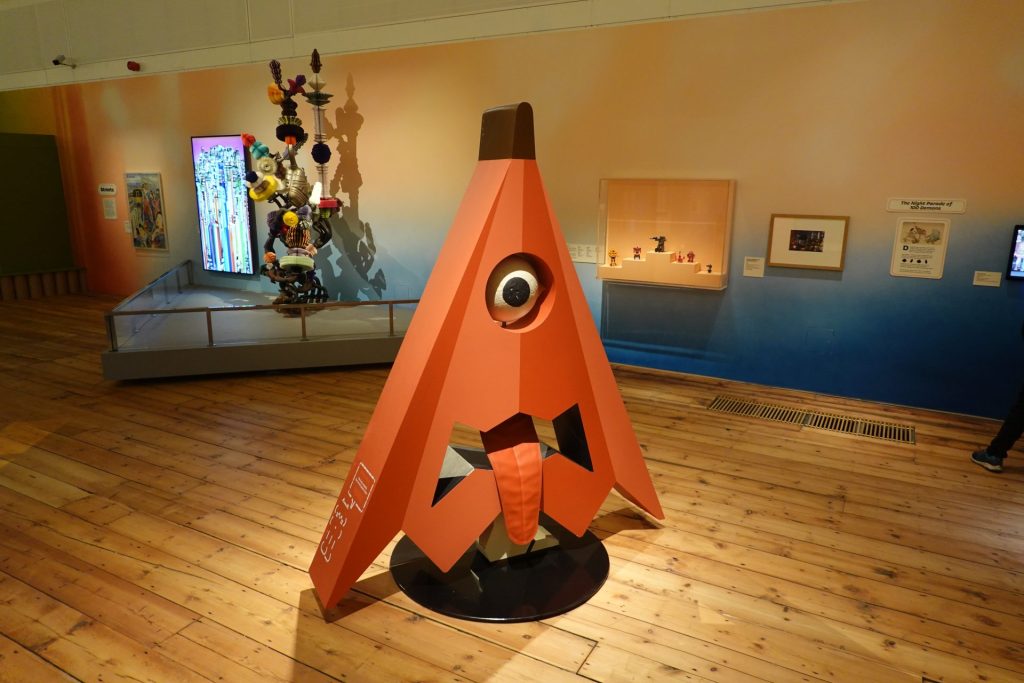The new Myths to Manga Exhibition at the Young V&A brings the Japanese countryside and cityscapes, and the myths behind them, to the heart of East London, providing families with a valuable, interactive exhibition sure to spark joy in every visitor.
Japan: Myths to Manga is the first exhibition at the Young V&A in Bethnal Green since the children museum’s reopening in July following a three year £13 million pound refurbishment and redesign.
The exhibition invites you to consider how raw elements – the sun, sea, sky and earth – were transmuted into myths centuries ago and from there were modernised into the increasingly recognisable characters and items known and loved today.
Attendees will see the same story of Urashima Tarō, a fisherman who saved a turtle only to receive a faustian bargain in return, retold through several different mediums: a plate, a carved figurine, a page in a hundred year old notebook and then finally as a plushie doll.

Katy Canales, a curator at Victoria and Albert Museum said: “I remember coming here as a child on a school trip, and it being fun because it had child related material and toys, but not being able to play with them is very different.
“And I think you come into the space now and it’s so light and colourful and there are so many interactions for people to play with.
“It’s a very different message to that quite Victorian feel that it was before.“
Beyond just being able to pick up and play with an array of items – including origami, manga drawing, a library with beanbags, a demon umbrella, and a set of drums flown all the way over from Tokyo – other aspects of the exhibition are designed with the child in mind.

From the low height of the exhibitions with their mounts carefully cut for size, to the Japanese ASCII emoticons dotted around the space at toddler height, suggesting fun activities to them.
Height brings a new role to certain objects, with the collection all standing at around 125cm, mounts are cut down or steps assembled upwards to put different objects in focus.
Canales’ favourite object in the collection is a tiny netsuke, a decorative toggle that would have fastened an inrō box carried on the front of a kimono-wearing gentlemen in the Edo Period (1603-1868).
Intricately carved with the face of a particularly grumpy tongue-cut sparrow, the piece is normally out of sight when hosted at the Toshiba Gallery at the main V&A museum over in South Kensington.
But here, properly elevated, the piece is given the space it needs to shine.

Much of the collection comes from mothership in West London, with curators there including Masami Yamada and Mary Redfern assisting with this display.
But the curators were able to tap into a wide network of partners, including the National Museum of Scotland, Bristol Museum & Art Gallery, The Whipple Museum at the University of Cambridge and The Japanese Gallery in Kensington. The drums and hee-less shoes for instance come from Noritaka Tatehana, a contemporary designer who shipped them over from Japan.

Canales said: “To have that kind of generosity is incredible and that buy in from artists and organisations from Japan house to the Embassy of Japan.
“That’s about stakeholder management and having those relationships where they really believe in what you’re doing and they believe that you represent that artwork in the collections appropriately.”
Full on purchases for temporary exhibitions are rare, as any object entering the national collection is permanent with each item justified to a committee with a care plan for its preservation.
Canales said: “Say you wanted a Pikachu, that would go through the same process as if it were a Donatella sculpture.”
Screens dotted around the space show clips from popular Japanese movies, mostly Studio Ghibli affairs like Pom Poko, Ponyo, The Tale of the Princess Kaguya and My Neighbour Totoro, the final film being supplemented with a model stage set designed by the Royal Shakespeare Company for their production at the Barbican.

The films on show had to be carefully handpicked – to be beautiful whilst sticking to the theme of balance in nature and without scaring children. The demon boar from Princess Mononoke did not make the cut.
Removing uncertainty and fear is a key part of the exhibition – even when it comes to the ticket. At £10, it is more a pass than a ticket, allowing the bearer to come back as many times as they like over the course of the run.
Canales said: “There is nothing worse than that you finally having packed up the buggy, you’ve got the pack lunch, you’ve gotten here on the tube and then the child has a tantrum or doesn’t want to do it and you paid your ticket price and you think ‘oh god we’re not going to see it’ and you have to leave.
“So this was about making taking away that anxiety, so that you can come back at any point.”
As a formerly horrible child, my mother would have rejoiced.

Originally slated to be open from October 2023 to August 2024, the exhibition is already proving popular, as thousands of visitors passed through the doors of Young V&A during October half-term and its run extended for a further month.
This will come with a tight turnaround as the entire collection will be carefully packaged up and shipped across the world to the Frist Art Museum in Nashville, Kentucky, USA for an October 2024 start date.
That will not be the only items leaving Bethnal Green. The hope is that the hundreds of origami cranes being created each day will be sent to the statue of Sadako Sasaki at Peace Memorial Park in Hiroshima.
Dying from radiation poisoning from the atomic bomb, nine-year-old Sadako folded a thousand cranes creating a senbazuru, which in Japanese tradition grants the maker one wish.
Sadako’s wish was not for her own life but for a world in peace. Passing away in 1955, the wish remains unfulfilled but still thousands of cranes from around the world, mostly sent by school children, adorn her statue.
Eight such senbazuru from the peace garden in Hiroshima hang from the rafters of the exhibition, a debt the museum will pay back in kind.
Canales said: “I wanted to represent that story because it relates to children, and it touches on the history of Japan and the Second World War and the impact of that, but it does it in a gentle way.
“This was a way of doing it that we could reflect on such a horrific part of history, and then also children’s resilience and creativity in the face of it.”
Despite all the kawaii objects, the cranes hoisted above act as good reminder that a children’s museum’s role is not just to host a collection of toys and placards but to inform and educate.

Drum and heel-less shoes images credited to Japan: Myths to Manga at Young V&A, London, 14 October 2023 – 11 August 2024 [sic]. Supported by Toshiba. With further support from Cockayne Grants for the Arts, a donor advised fund held at The London Community Foundation.





Join the discussion